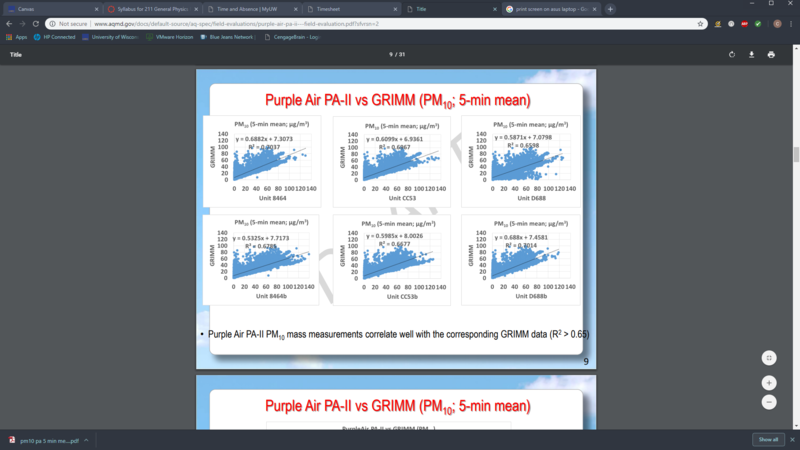I work for a research team for the University of Wisconsin Eau Claire, and we are attempting to discern the validity of the data that is generated from the purple air monitors. Listed following this is a link to the AQI field test of the purple air monitor. This field test showed the PM10 to be biased rather high. http://www.aqmd.gov/docs/default-source/aq-spec/field-evaluations/purple-air-pa-ii---field-evaluation.pdf?sfvrsn=2
Laser scattering based PM sensor has tendency to show inaccuracy in particle between 2.5-10 um in size. Since Purple air as per specification i see is based on laser light scattering. Its mainly because, the laser light scattered after particle at given wavelength range (e.g 640 nm wavelength based laser are commonly used ). This results particle size near by this wavelength for e.g 1 micron size particle can be measured accurately . Technically , because of MIE scattering principle . Near laser light wavelength you will get more accuracy in particle size measurement and as you go for from laser wavelength, the accuracy in size measurement will decrease.
Apart from this Relative humidity and sampling inlet design also influence the PM measurement .
I found the information about the 640 nm wavelength lasers quite interesting, thank you. I have been in communication from people from Lane Regional Air Protection Agency in Oregon, and they believe that, since the sensors on the Purple Air monitor require air to be pulled up to the sensors, and that the flow is not high enough to get the PM10 particles to go through? What do you think about this, and also, if the air flow isn't high enough for PM10 particles to get into the sensors, why does the instrument tend to bias high with PM10 when the air flow may not be sufficient for it to capture PM10 particles? I'm very intrigued about all of this, so any help is greatly appreciated
Is this a question? Click here to post it to the Questions page.
Reply to this comment...
Log in to comment
I'd appreciate learning what in the document you referenced indicates to you that the PM10 is "biased rather high". Thanks
Reply to this comment...
Log in to comment
Hi @Cbarnes9 thanks for sharing out the questions! I'm also curious where you're referencing the field test for PM10 to be biased high? Is it in that AQMD doc? I'm not seeing it. Can you copy paste of screenshot in where you're seeing that?
Is this a question? Click here to post it to the Questions page.
Reply to this comment...
Log in to comment
The field evaluation report linked above includes 78 graphs comparing the results of a Purple Air sensor with a $25k GRIMM optical particle counter. Every one of those graphs indicates that the Purple Air sensor produces a higher reading than the GRIMM reference sensor. A example is below. Fortunately, the regression equations for each comparison are presented, so these can be used to adjust the readings of a Purple Air sensor to more accurate values.
Chris
Reply to this comment...
Log in to comment
@cfastie is certainly correct in his comments that each of the purple air devices reads, in general, higher than the Grimm. (Almost all slopes (coefficients of the "x" variable) in the regression equations are less than one. But @Cbarnes9 question specifically refers to PM10 and the SCAQMD specifically calls the PM1 and PM2.5 data "quite accurate" while not using the same description for the PM10 data.
In addition because @Cbarnes9 categorizes the PM10 bias as "so high" I would assume that he/she considers the "amount" of bias for PM10 as considerably different than that for the other sizes. To help answer the original question I would think one needs to understand why.
Reply to this comment...
Log in to comment
Hello everyone, sorry for the late replies; I am posting the field study results from AQMD that I was referencing. Their tests indicate that the PM10 R2 values in reference to the FEM BAM and FEM GRIMM are only about .6 - .75, being biased high on the low concentration end, and low on the high concentration end. I have done some more research and I believe that it is due to the application of the MIE scattering principle being used. 640nm (which is the wavelength of the lasers on the PurpleAir) is only about 6% of the size of a PM10 particle. That being said, with it so much smaller than PM10, MIE scattering isn't necessarily the best scatter method to use for accurate particle measurement.
Reply to this comment...
Log in to comment